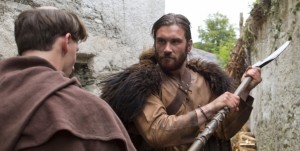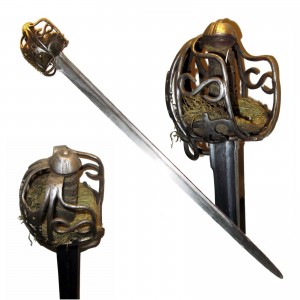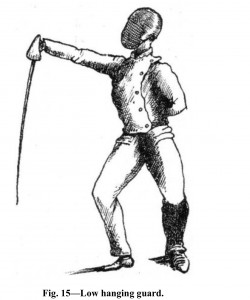“Who was the first who forged the deadly blade?
Of rugged steel his savage soul was made!” – Tibullus
Swords Gone By
A shopping mall in a city where I attended College had two primary attractions: a Borders Bookstore and a movie theatre. For me and my group of friends, there was one other store that kept us coming back: a Golf and Gift Shop. It was full of kitschy little do-dads, trinkets, and ridiculous impractical golf gear (as well as legit clubs and bags), but we didn’t care much about Golf. We came for the swords.
I often wonder how a golf shop got into the sword business. They were mostly fantasy blades, and in retrospect I would bet a lot were half-tang and unlikely to stand up to actual combat. But we didn’t care about that. They looked cool, and they ignited our imaginations. We probably drove the shop-keepers nuts because we were always looking but never buying. Being a broke commuting college student, my money was tied up in truck payments, gasoline, and books.
However, there was a time when a sword was considered a much wiser and sounder investment than any book or vehicle. But for the Medieval warrior with the luxury of choosing, the question remained – what kind of sword should they wield?
Origins of Medieval Swords
Early Period Swords (400ish CE-1000 CE)
When the Roman Empire fell, its soldiers had long since replaced the relatively short-bladed Gladius for its long-bladed descendant the Spatha. The soldiers would reach around large oval shields with the long blade and stab at their enemies.

Re-enactor wielding a Spatha. Source: Wikipedia.
For the purpose of simplicity, we’ll limit our exploration to swords with both sides sharpened. Starting with the Viking Sword, which as you can see below looks a lot like a Spatha:

An assortment of Viking Swords. Note the characteristic one-hand grip and long, double-sided blade. Source: Wikimedia Commons
A quick note about the Vikings, however, and about Medieval Europe as well: while the sword may have been a preferred weapon among the ruling and military classes, the common people often opted for spears or other pole arms. The Vikings in particular (by which I mean the pirate raiders, not the people) were fond of Axes.

Pictured: Historical Accuracy. Source: History Channel
The battle axe was a fearsome weapon, capable of splitting a wooden targe as well as someone’s skull. Viking tactics varied depending on the foes they faced. When raiding unsuspecting settlements, they would use quick weapons like the axe, but if they were caught in a pitched battle, they would use the phalanx-like “shield wall” and jab at the enemy with swords and spears.
High Period Swords (1000ish CE-1300 CE)
The Military class of the High Medieval Period, whom we know as the Knights and Men-at-Arms, came to use a different sword. Like the Spatha and Viking sword, it had a short one-handed hilt and a blade about an arm’s length. It was known as the Arming Sword.

An illustration of an Arming Sword. Note the change in the design of the handguard as well as the more gradual tapering leading to a fine point (good for stabbing into armor gaps!). Source: Wikimedia Commons.
The main difference from its predecessors was that the Arming Sword had a much more defined point, important when facing an armored opponent. Despite what Hollywood likes to show us, plate armor was actually a pretty effective defense against direct hits from melee weapons, and even chain mail could prevent being wounded by a swinging sword.
Tactics had to change as plate armor became more and more common among fief-owning Knights and salaried Men-at-Arms, so a weapon versatile enough to either swing or chop was very valuable. Every armor has its weak points, and someone experienced in fighting with an Arming Sword could slip the slim, sharp-tipped blade right through a helm’s narrow eye-slit.
Late Period Swords (1300 CE to 1500 CE)
When Europeans discovered gunpowder (long after the Chinese, by the way), tactics and strategies gradually changed as firearm technology advanced. Different tactics called for new weapons. Enter the Longswords:

The sword so famous they named a land mine after it! Source: Wikimedia Commons
“But Justin,” I can already hear you protesting, “that’s not a longsword, it’s a broadsword!” Nope. Not a broadsword, not by a long shot. We’ll get to broadswords in a second, but the Scottish Claymore pictured above is a longsword, and I’ll tell you why.
The hilt. That’s right, it’s not the length or width of the actual blade that determines its label as a Longsword or Broadsword, but the length of its grip. A hand-and-a-half “Bastard” Sword is an example of a Longsword, as well. Also, sorry Braveheart fans, but the Scottish Claymore specifically didn’t come into common use until the 1400’s, almost a hundred years after the events depicted in the film. And that’s not even the grossest example of the film’s fast-and-loose approach to historical accuracy and realism.

Pictured: NOT Historical Accuracy. A movie with problematic depictions of both English and Scots. Source: Wikipedia
Longsword combat was not so much hack-and-slash as it was grapple-and-stab. Fighting manuals from the time depict practitioners grabbing the actual blade and using it like a spear. In fact, there are some groups of re-enactors today who utilize the illustrations and instructions in these old books to try and reconstruct Medieval fighting techniques, like the Association for Renaissance Martial Arts. Here’s one of their video demonstrations: (Don’t try at home unless you’re looking to lose a limb!)
And in case you’re thinking that they just made up those movements or even appropriated jiu jitsu or other Eastern techniques, here’s one of many illustrations that looks strikingly similar:

Far from the hack-and-slash so often portrayed in movies and TV, Medieval Martial Arts were more about grappling and leverage than broad strikes and swashbuckling. From the Codex Wallerstein, Source: Wikipedia.
So why does Hollywood so often depict hack-and-slash style fighting when it was so clearly different? Probably because of the double-sided sword’s most recent evolution: the Broadsword.
Early Modern Period

At long last, a real broadsword. Source: Wikipedia.
Fencing is the most common sword-based Martial Art practiced today, and its principle weapon, the Foil, is based on a thrusting sword called the Rapier. Rapiers have little or no edge, but a vicious point for stabbing. Broadswords earned their name because they have a broader blade than the more common Rapiers. Also, the Rapier was found among civilians, but soldiers generally preferred a Broadsword or Saber.
Because of their different balance and weight distribution, Broadsword fighting techniques are different from what average fencers learn, especially their options for opening stance:

Different guards make for different options for opening moves, as well as varying levels of defensibility. Source: Gutenberg Books.
Remember: History is Messy
One final note for history’s sake: don’t imagine that just because the Arming Sword was most heavily utilized during the 1000’s means people weren’t still using them in the 1500’s. It wasn’t as though there was some kind of central authority going around replacing people’s swords when newer ones came into fashion. Generally, fighters chose their weapons based on their preference of fighting style, and economic capabilities. A weapon that was both useable and affordable was right in the sweet spot.
I find it interesting that Medieval swords more or less began short-bladed with the Arming Sword, became large and long, then shrunk back to being around the same size. The Handguards you’ll find on Broadswords and Rapiers became necessary partly because warriors no longer had armored gauntlets to protect their fingers, and dropping your sword is pretty much a guaranteed way to lose a sword fight.
As much ground as we’ve covered historically, we’ve barely scratched the surface of the different weapons used in the Medieval Period. If you want to hear more about Falchions, Crossbows, Longbows, Lances, and many other period weapons, sign up for the Mailing List, which includes exclusive content which I don’t have on the blog. Also, you’ll be the first to hear when my first book, A Test of Honor is finished and even get an exclusive discounted price!
Further Reading:
The Physical Realities of Forceful Edge-to-Edge Impacts – Great article examining how different sword techniques affected the life of a blade.
Skills and Attributes: Training for Combat – All about the training needed to properly learn a Martial Art
How Were Swords Really Made? – Interesting piece about what we do and don’t know about swordmaking.


Quite informative blog for those who want to explore on Medieval swords. They have always been in limelight as antique collectibles nowadays. Though in Medieval times they were the only weapon for survival.
Makes me wonder what kind of everyday items from our day will be future collectibles – cd-roms, tablets, maybe even simpler things like ice trays!